Desklib - Online Library for Study Material and Solved Assignments
VerifiedAdded on 2023/04/03
|18
|3076
|277
AI Summary
Desklib is an online library that offers study material, solved assignments, essays, and dissertations for students. It provides a wide range of content for various subjects and courses. Whether you need help with your assignments or want to enhance your knowledge, Desklib has got you covered.
Contribute Materials
Your contribution can guide someone’s learning journey. Share your
documents today.
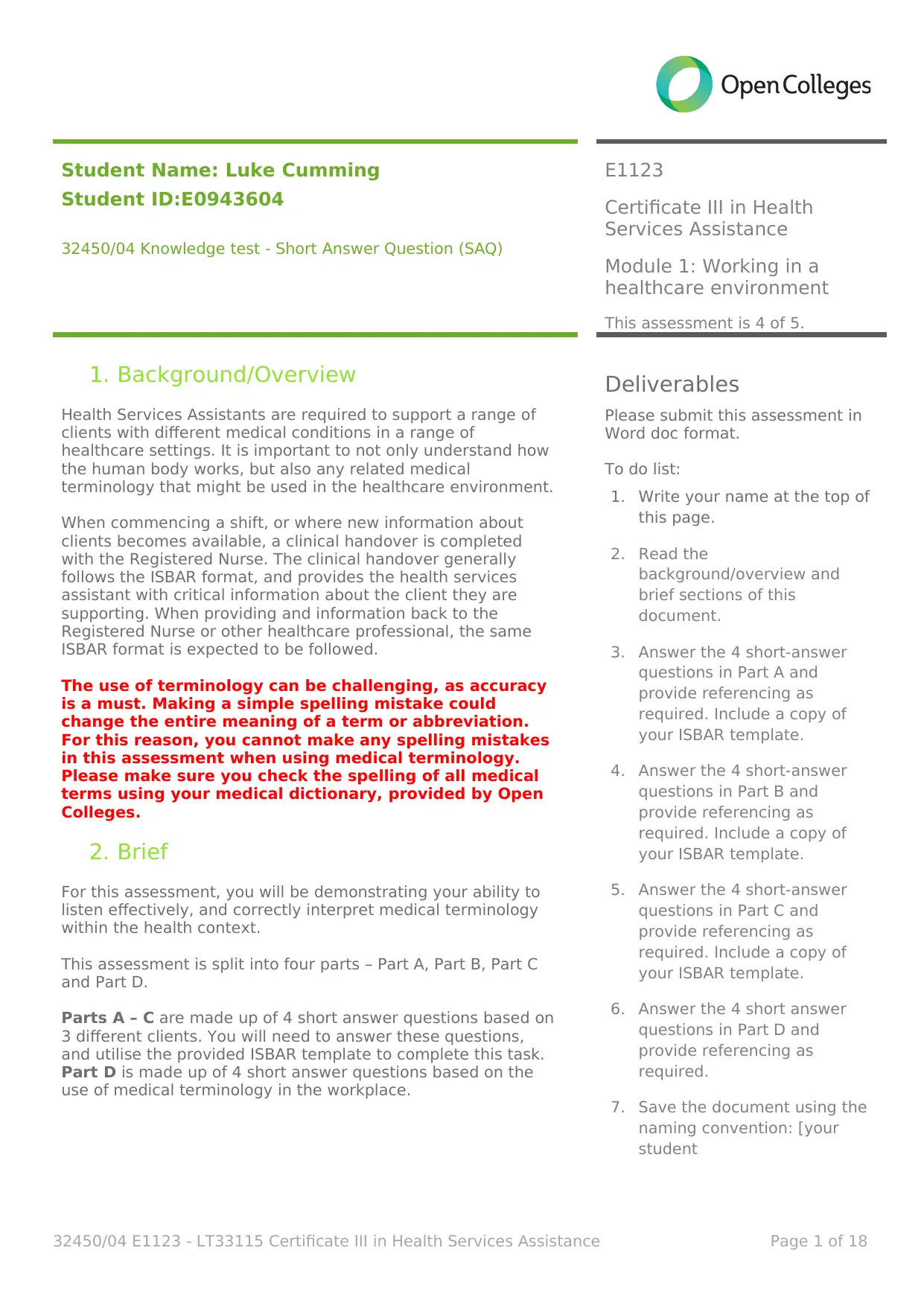
Student Name: Luke Cumming
Student ID:E0943604
32450/04 Knowledge test - Short Answer Question (SAQ)
E1123
Certificate III in Health
Services Assistance
Module 1: Working in a
healthcare environment
This assessment is 4 of 5.
1. Background/Overview
Health Services Assistants are required to support a range of
clients with different medical conditions in a range of
healthcare settings. It is important to not only understand how
the human body works, but also any related medical
terminology that might be used in the healthcare environment.
When commencing a shift, or where new information about
clients becomes available, a clinical handover is completed
with the Registered Nurse. The clinical handover generally
follows the ISBAR format, and provides the health services
assistant with critical information about the client they are
supporting. When providing and information back to the
Registered Nurse or other healthcare professional, the same
ISBAR format is expected to be followed.
The use of terminology can be challenging, as accuracy
is a must. Making a simple spelling mistake could
change the entire meaning of a term or abbreviation.
For this reason, you cannot make any spelling mistakes
in this assessment when using medical terminology.
Please make sure you check the spelling of all medical
terms using your medical dictionary, provided by Open
Colleges.
2. Brief
For this assessment, you will be demonstrating your ability to
listen effectively, and correctly interpret medical terminology
within the health context.
This assessment is split into four parts – Part A, Part B, Part C
and Part D.
Parts A – C are made up of 4 short answer questions based on
3 different clients. You will need to answer these questions,
and utilise the provided ISBAR template to complete this task.
Part D is made up of 4 short answer questions based on the
use of medical terminology in the workplace.
Deliverables
Please submit this assessment in
Word doc format.
To do list:
1. Write your name at the top of
this page.
2. Read the
background/overview and
brief sections of this
document.
3. Answer the 4 short-answer
questions in Part A and
provide referencing as
required. Include a copy of
your ISBAR template.
4. Answer the 4 short-answer
questions in Part B and
provide referencing as
required. Include a copy of
your ISBAR template.
5. Answer the 4 short-answer
questions in Part C and
provide referencing as
required. Include a copy of
your ISBAR template.
6. Answer the 4 short answer
questions in Part D and
provide referencing as
required.
7. Save the document using the
naming convention: [your
student
32450/04 E1123 - LT33115 Certificate III in Health Services Assistance Page 1 of 18
Student ID:E0943604
32450/04 Knowledge test - Short Answer Question (SAQ)
E1123
Certificate III in Health
Services Assistance
Module 1: Working in a
healthcare environment
This assessment is 4 of 5.
1. Background/Overview
Health Services Assistants are required to support a range of
clients with different medical conditions in a range of
healthcare settings. It is important to not only understand how
the human body works, but also any related medical
terminology that might be used in the healthcare environment.
When commencing a shift, or where new information about
clients becomes available, a clinical handover is completed
with the Registered Nurse. The clinical handover generally
follows the ISBAR format, and provides the health services
assistant with critical information about the client they are
supporting. When providing and information back to the
Registered Nurse or other healthcare professional, the same
ISBAR format is expected to be followed.
The use of terminology can be challenging, as accuracy
is a must. Making a simple spelling mistake could
change the entire meaning of a term or abbreviation.
For this reason, you cannot make any spelling mistakes
in this assessment when using medical terminology.
Please make sure you check the spelling of all medical
terms using your medical dictionary, provided by Open
Colleges.
2. Brief
For this assessment, you will be demonstrating your ability to
listen effectively, and correctly interpret medical terminology
within the health context.
This assessment is split into four parts – Part A, Part B, Part C
and Part D.
Parts A – C are made up of 4 short answer questions based on
3 different clients. You will need to answer these questions,
and utilise the provided ISBAR template to complete this task.
Part D is made up of 4 short answer questions based on the
use of medical terminology in the workplace.
Deliverables
Please submit this assessment in
Word doc format.
To do list:
1. Write your name at the top of
this page.
2. Read the
background/overview and
brief sections of this
document.
3. Answer the 4 short-answer
questions in Part A and
provide referencing as
required. Include a copy of
your ISBAR template.
4. Answer the 4 short-answer
questions in Part B and
provide referencing as
required. Include a copy of
your ISBAR template.
5. Answer the 4 short-answer
questions in Part C and
provide referencing as
required. Include a copy of
your ISBAR template.
6. Answer the 4 short answer
questions in Part D and
provide referencing as
required.
7. Save the document using the
naming convention: [your
student
32450/04 E1123 - LT33115 Certificate III in Health Services Assistance Page 1 of 18
Secure Best Marks with AI Grader
Need help grading? Try our AI Grader for instant feedback on your assignments.
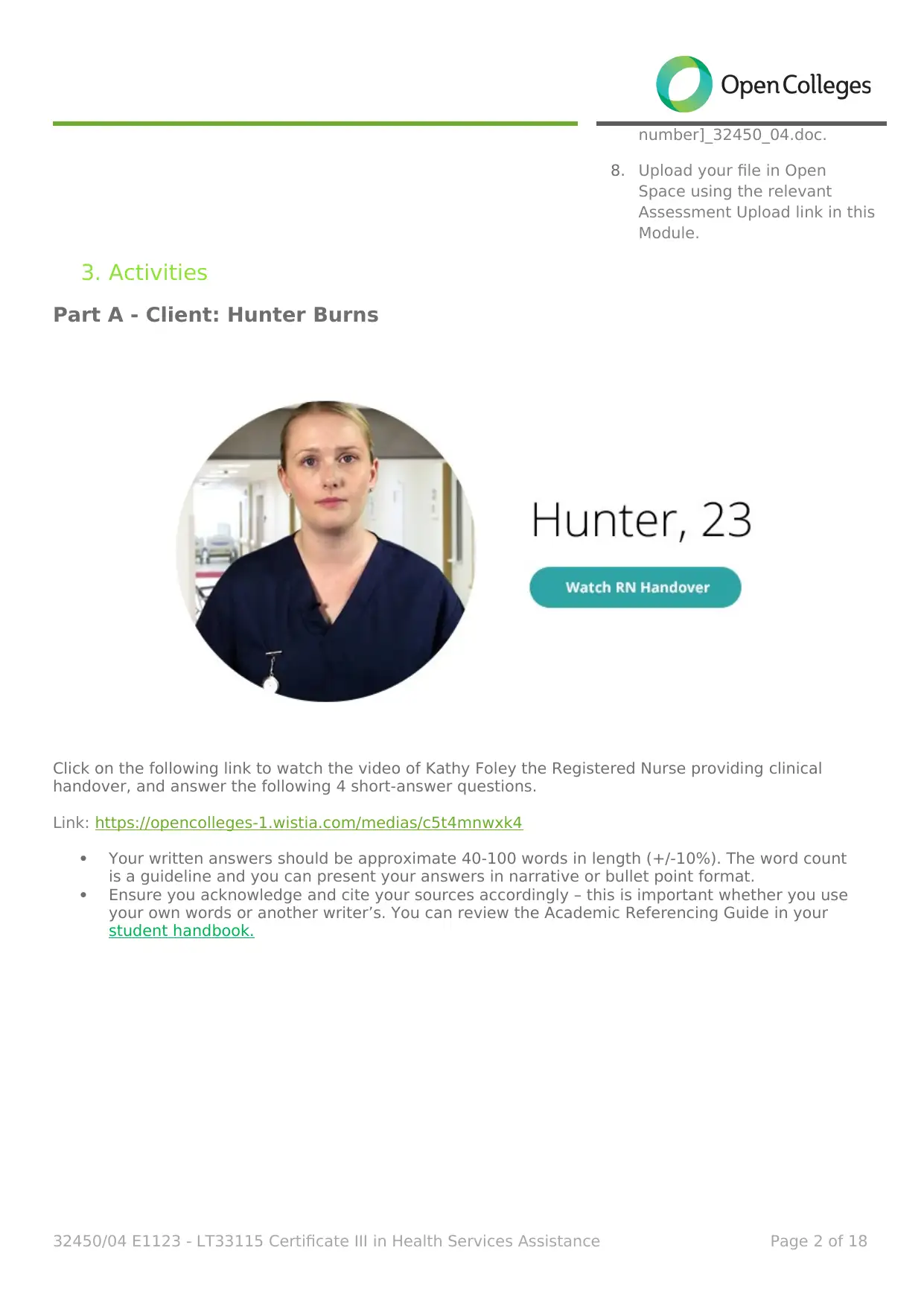
number]_32450_04.doc.
8. Upload your file in Open
Space using the relevant
Assessment Upload link in this
Module.
3. Activities
Part A - Client: Hunter Burns
Click on the following link to watch the video of Kathy Foley the Registered Nurse providing clinical
handover, and answer the following 4 short-answer questions.
Link: https://opencolleges-1.wistia.com/medias/c5t4mnwxk4
Your written answers should be approximate 40-100 words in length (+/-10%). The word count
is a guideline and you can present your answers in narrative or bullet point format.
Ensure you acknowledge and cite your sources accordingly – this is important whether you use
your own words or another writer’s. You can review the Academic Referencing Guide in your
student handbook.
32450/04 E1123 - LT33115 Certificate III in Health Services Assistance Page 2 of 18
8. Upload your file in Open
Space using the relevant
Assessment Upload link in this
Module.
3. Activities
Part A - Client: Hunter Burns
Click on the following link to watch the video of Kathy Foley the Registered Nurse providing clinical
handover, and answer the following 4 short-answer questions.
Link: https://opencolleges-1.wistia.com/medias/c5t4mnwxk4
Your written answers should be approximate 40-100 words in length (+/-10%). The word count
is a guideline and you can present your answers in narrative or bullet point format.
Ensure you acknowledge and cite your sources accordingly – this is important whether you use
your own words or another writer’s. You can review the Academic Referencing Guide in your
student handbook.
32450/04 E1123 - LT33115 Certificate III in Health Services Assistance Page 2 of 18
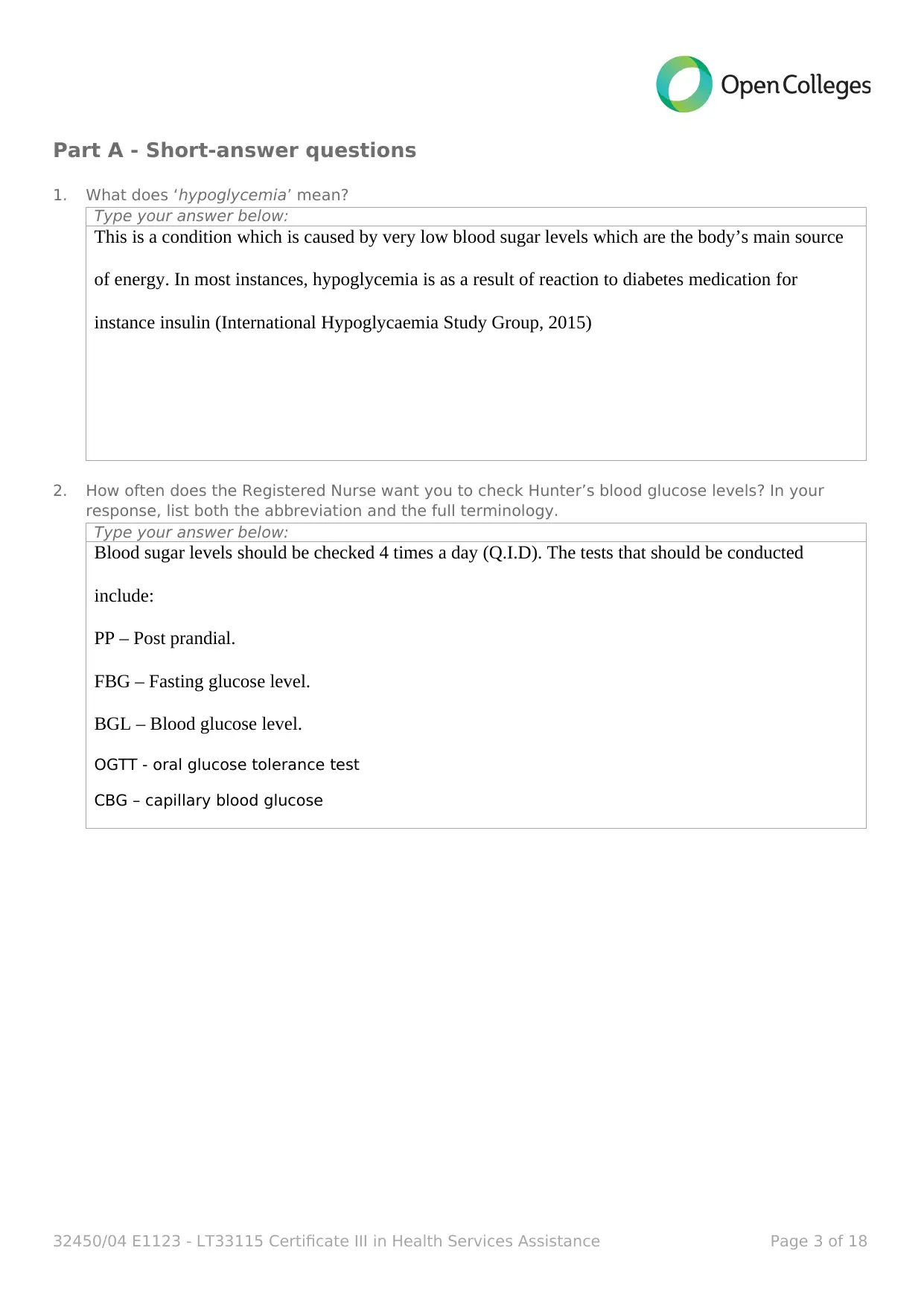
Part A - Short-answer questions
1. What does ‘hypoglycemia’ mean?
Type your answer below:
This is a condition which is caused by very low blood sugar levels which are the body’s main source
of energy. In most instances, hypoglycemia is as a result of reaction to diabetes medication for
instance insulin (International Hypoglycaemia Study Group, 2015)
2. How often does the Registered Nurse want you to check Hunter’s blood glucose levels? In your
response, list both the abbreviation and the full terminology.
Type your answer below:
Blood sugar levels should be checked 4 times a day (Q.I.D). The tests that should be conducted
include:
PP – Post prandial.
FBG – Fasting glucose level.
BGL – Blood glucose level.
OGTT - oral glucose tolerance test
CBG – capillary blood glucose
32450/04 E1123 - LT33115 Certificate III in Health Services Assistance Page 3 of 18
1. What does ‘hypoglycemia’ mean?
Type your answer below:
This is a condition which is caused by very low blood sugar levels which are the body’s main source
of energy. In most instances, hypoglycemia is as a result of reaction to diabetes medication for
instance insulin (International Hypoglycaemia Study Group, 2015)
2. How often does the Registered Nurse want you to check Hunter’s blood glucose levels? In your
response, list both the abbreviation and the full terminology.
Type your answer below:
Blood sugar levels should be checked 4 times a day (Q.I.D). The tests that should be conducted
include:
PP – Post prandial.
FBG – Fasting glucose level.
BGL – Blood glucose level.
OGTT - oral glucose tolerance test
CBG – capillary blood glucose
32450/04 E1123 - LT33115 Certificate III in Health Services Assistance Page 3 of 18
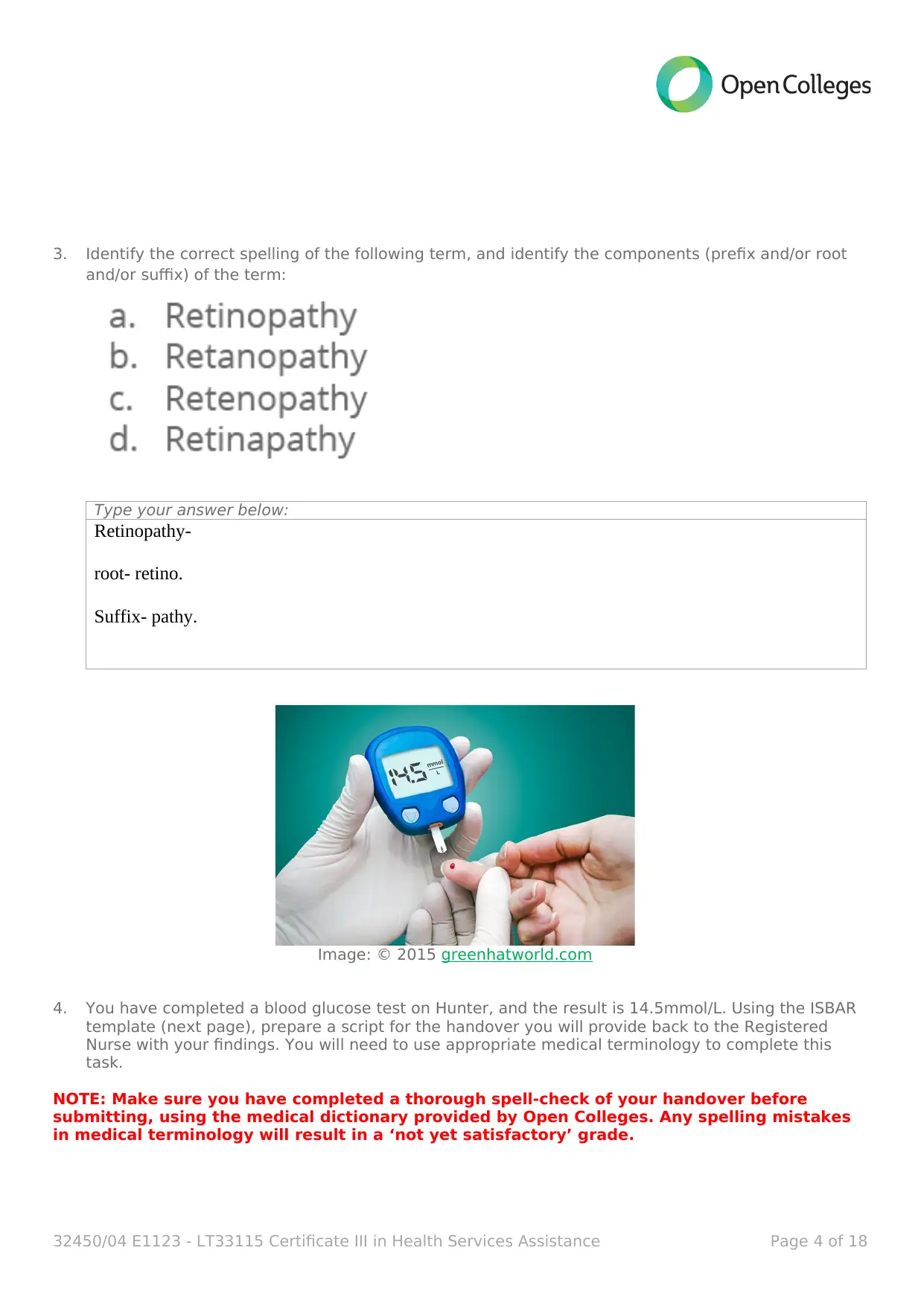
3. Identify the correct spelling of the following term, and identify the components (prefix and/or root
and/or suffix) of the term:
Type your answer below:
Retinopathy-
root- retino.
Suffix- pathy.
Image: © 2015 greenhatworld.com
4. You have completed a blood glucose test on Hunter, and the result is 14.5mmol/L. Using the ISBAR
template (next page), prepare a script for the handover you will provide back to the Registered
Nurse with your findings. You will need to use appropriate medical terminology to complete this
task.
NOTE: Make sure you have completed a thorough spell-check of your handover before
submitting, using the medical dictionary provided by Open Colleges. Any spelling mistakes
in medical terminology will result in a ‘not yet satisfactory’ grade.
32450/04 E1123 - LT33115 Certificate III in Health Services Assistance Page 4 of 18
and/or suffix) of the term:
Type your answer below:
Retinopathy-
root- retino.
Suffix- pathy.
Image: © 2015 greenhatworld.com
4. You have completed a blood glucose test on Hunter, and the result is 14.5mmol/L. Using the ISBAR
template (next page), prepare a script for the handover you will provide back to the Registered
Nurse with your findings. You will need to use appropriate medical terminology to complete this
task.
NOTE: Make sure you have completed a thorough spell-check of your handover before
submitting, using the medical dictionary provided by Open Colleges. Any spelling mistakes
in medical terminology will result in a ‘not yet satisfactory’ grade.
32450/04 E1123 - LT33115 Certificate III in Health Services Assistance Page 4 of 18
Secure Best Marks with AI Grader
Need help grading? Try our AI Grader for instant feedback on your assignments.
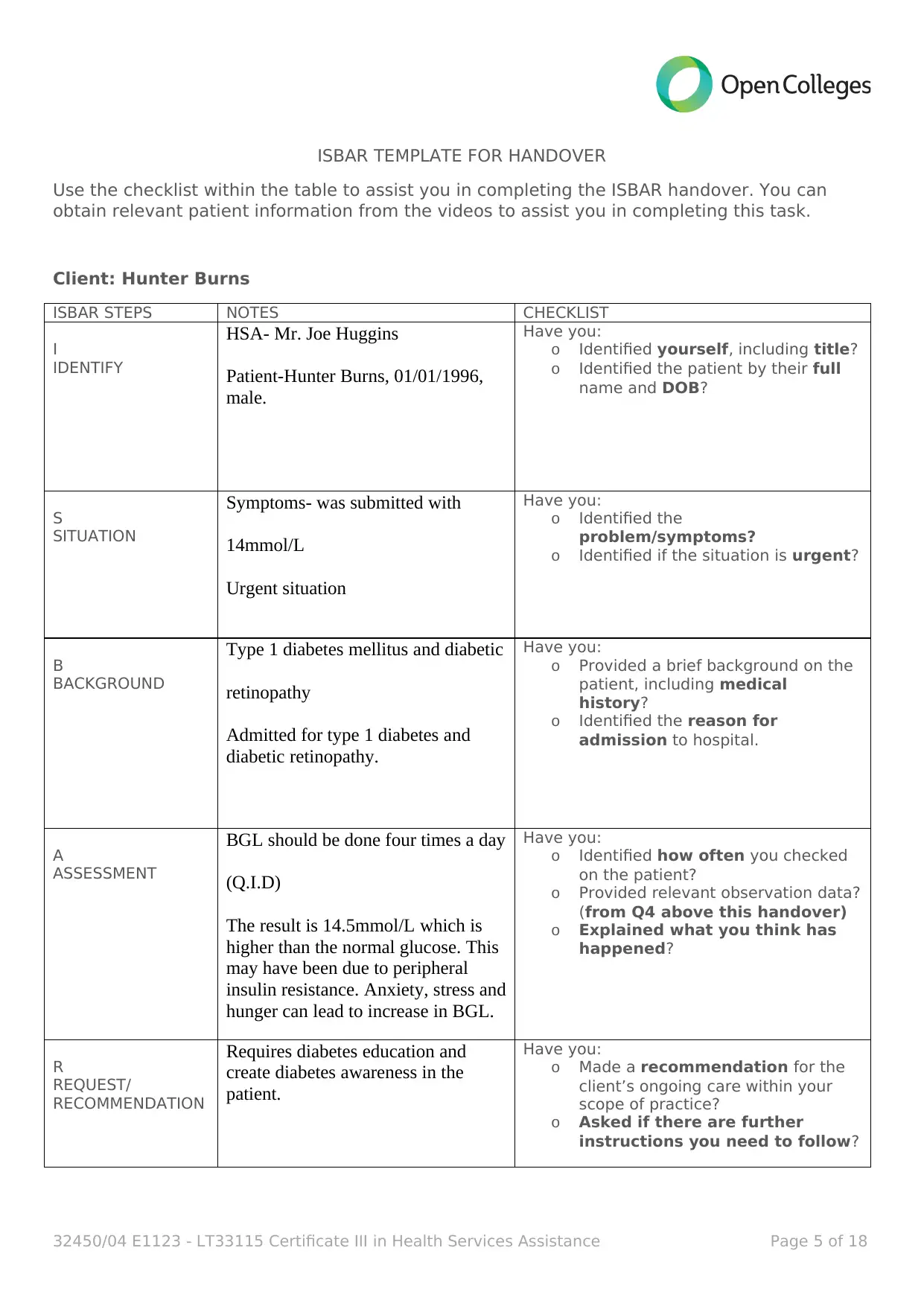
ISBAR TEMPLATE FOR HANDOVER
Use the checklist within the table to assist you in completing the ISBAR handover. You can
obtain relevant patient information from the videos to assist you in completing this task.
Client: Hunter Burns
ISBAR STEPS NOTES CHECKLIST
I
IDENTIFY
HSA- Mr. Joe Huggins
Patient-Hunter Burns, 01/01/1996,
male.
Have you:
o Identified yourself, including title?
o Identified the patient by their full
name and DOB?
S
SITUATION
Symptoms- was submitted with
14mmol/L
Urgent situation
Have you:
o Identified the
problem/symptoms?
o Identified if the situation is urgent?
B
BACKGROUND
Type 1 diabetes mellitus and diabetic
retinopathy
Admitted for type 1 diabetes and
diabetic retinopathy.
Have you:
o Provided a brief background on the
patient, including medical
history?
o Identified the reason for
admission to hospital.
A
ASSESSMENT
BGL should be done four times a day
(Q.I.D)
The result is 14.5mmol/L which is
higher than the normal glucose. This
may have been due to peripheral
insulin resistance. Anxiety, stress and
hunger can lead to increase in BGL.
Have you:
o Identified how often you checked
on the patient?
o Provided relevant observation data?
(from Q4 above this handover)
o Explained what you think has
happened?
R
REQUEST/
RECOMMENDATION
Requires diabetes education and
create diabetes awareness in the
patient.
Have you:
o Made a recommendation for the
client’s ongoing care within your
scope of practice?
o Asked if there are further
instructions you need to follow?
32450/04 E1123 - LT33115 Certificate III in Health Services Assistance Page 5 of 18
Use the checklist within the table to assist you in completing the ISBAR handover. You can
obtain relevant patient information from the videos to assist you in completing this task.
Client: Hunter Burns
ISBAR STEPS NOTES CHECKLIST
I
IDENTIFY
HSA- Mr. Joe Huggins
Patient-Hunter Burns, 01/01/1996,
male.
Have you:
o Identified yourself, including title?
o Identified the patient by their full
name and DOB?
S
SITUATION
Symptoms- was submitted with
14mmol/L
Urgent situation
Have you:
o Identified the
problem/symptoms?
o Identified if the situation is urgent?
B
BACKGROUND
Type 1 diabetes mellitus and diabetic
retinopathy
Admitted for type 1 diabetes and
diabetic retinopathy.
Have you:
o Provided a brief background on the
patient, including medical
history?
o Identified the reason for
admission to hospital.
A
ASSESSMENT
BGL should be done four times a day
(Q.I.D)
The result is 14.5mmol/L which is
higher than the normal glucose. This
may have been due to peripheral
insulin resistance. Anxiety, stress and
hunger can lead to increase in BGL.
Have you:
o Identified how often you checked
on the patient?
o Provided relevant observation data?
(from Q4 above this handover)
o Explained what you think has
happened?
R
REQUEST/
RECOMMENDATION
Requires diabetes education and
create diabetes awareness in the
patient.
Have you:
o Made a recommendation for the
client’s ongoing care within your
scope of practice?
o Asked if there are further
instructions you need to follow?
32450/04 E1123 - LT33115 Certificate III in Health Services Assistance Page 5 of 18

32450/04 E1123 - LT33115 Certificate III in Health Services Assistance Page 6 of 18
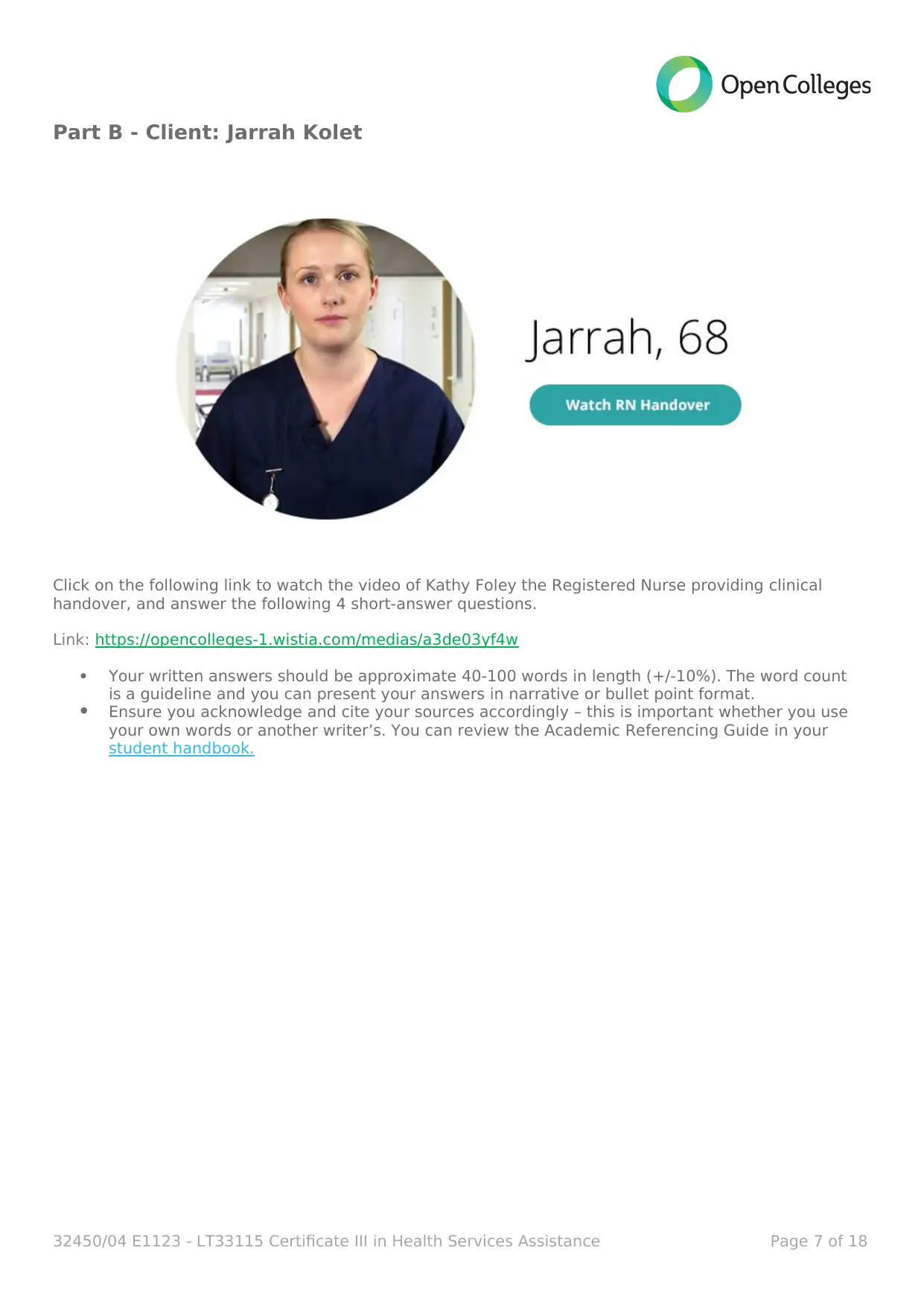
Part B - Client: Jarrah Kolet
Click on the following link to watch the video of Kathy Foley the Registered Nurse providing clinical
handover, and answer the following 4 short-answer questions.
Link: https://opencolleges-1.wistia.com/medias/a3de03yf4w
Your written answers should be approximate 40-100 words in length (+/-10%). The word count
is a guideline and you can present your answers in narrative or bullet point format.
Ensure you acknowledge and cite your sources accordingly – this is important whether you use
your own words or another writer’s. You can review the Academic Referencing Guide in your
student handbook.
32450/04 E1123 - LT33115 Certificate III in Health Services Assistance Page 7 of 18
Click on the following link to watch the video of Kathy Foley the Registered Nurse providing clinical
handover, and answer the following 4 short-answer questions.
Link: https://opencolleges-1.wistia.com/medias/a3de03yf4w
Your written answers should be approximate 40-100 words in length (+/-10%). The word count
is a guideline and you can present your answers in narrative or bullet point format.
Ensure you acknowledge and cite your sources accordingly – this is important whether you use
your own words or another writer’s. You can review the Academic Referencing Guide in your
student handbook.
32450/04 E1123 - LT33115 Certificate III in Health Services Assistance Page 7 of 18
Paraphrase This Document
Need a fresh take? Get an instant paraphrase of this document with our AI Paraphraser
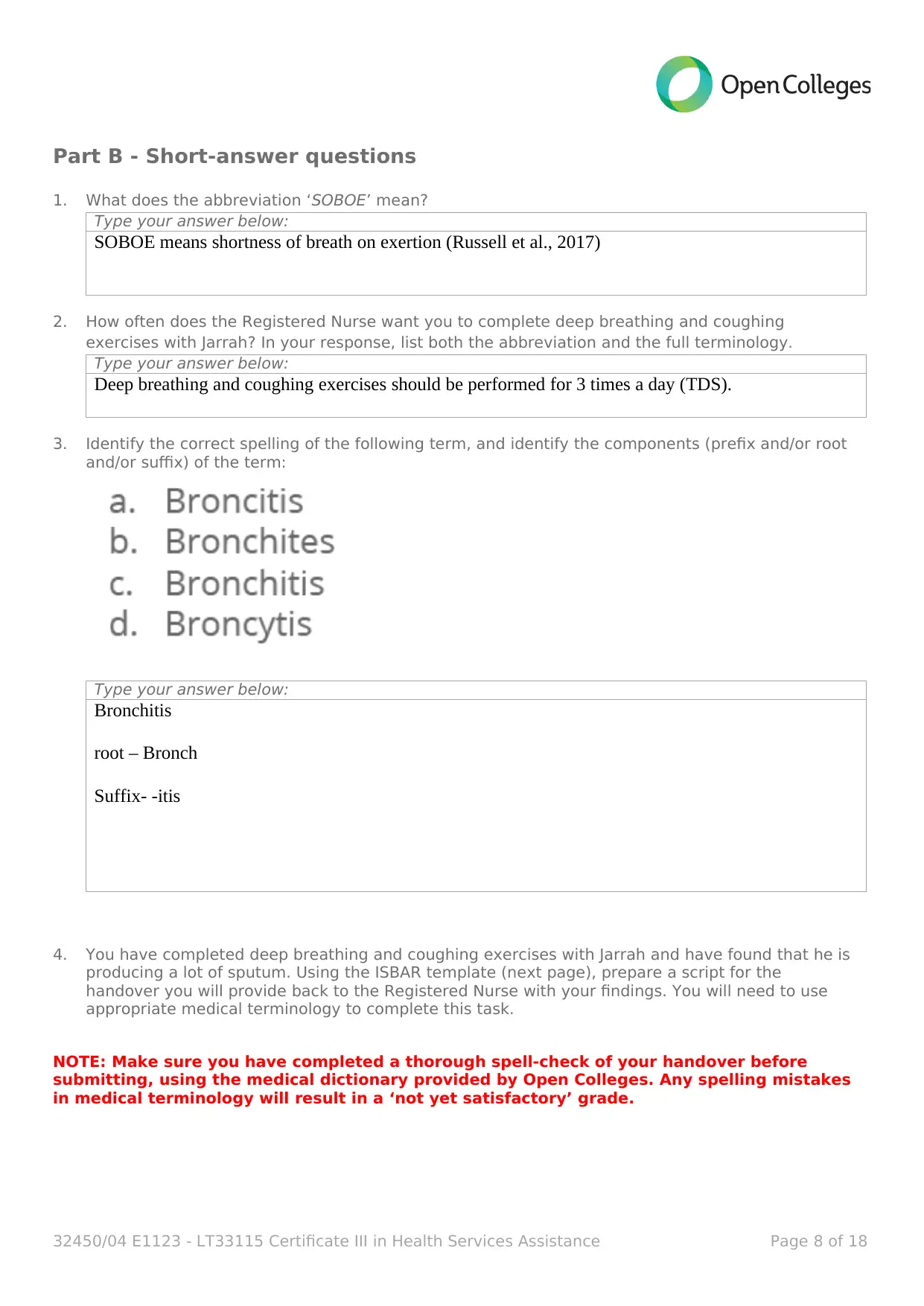
Part B - Short-answer questions
1. What does the abbreviation ‘SOBOE’ mean?
Type your answer below:
SOBOE means shortness of breath on exertion (Russell et al., 2017)
2. How often does the Registered Nurse want you to complete deep breathing and coughing
exercises with Jarrah? In your response, list both the abbreviation and the full terminology.
Type your answer below:
Deep breathing and coughing exercises should be performed for 3 times a day (TDS).
3. Identify the correct spelling of the following term, and identify the components (prefix and/or root
and/or suffix) of the term:
Type your answer below:
Bronchitis
root – Bronch
Suffix- -itis
4. You have completed deep breathing and coughing exercises with Jarrah and have found that he is
producing a lot of sputum. Using the ISBAR template (next page), prepare a script for the
handover you will provide back to the Registered Nurse with your findings. You will need to use
appropriate medical terminology to complete this task.
NOTE: Make sure you have completed a thorough spell-check of your handover before
submitting, using the medical dictionary provided by Open Colleges. Any spelling mistakes
in medical terminology will result in a ‘not yet satisfactory’ grade.
32450/04 E1123 - LT33115 Certificate III in Health Services Assistance Page 8 of 18
1. What does the abbreviation ‘SOBOE’ mean?
Type your answer below:
SOBOE means shortness of breath on exertion (Russell et al., 2017)
2. How often does the Registered Nurse want you to complete deep breathing and coughing
exercises with Jarrah? In your response, list both the abbreviation and the full terminology.
Type your answer below:
Deep breathing and coughing exercises should be performed for 3 times a day (TDS).
3. Identify the correct spelling of the following term, and identify the components (prefix and/or root
and/or suffix) of the term:
Type your answer below:
Bronchitis
root – Bronch
Suffix- -itis
4. You have completed deep breathing and coughing exercises with Jarrah and have found that he is
producing a lot of sputum. Using the ISBAR template (next page), prepare a script for the
handover you will provide back to the Registered Nurse with your findings. You will need to use
appropriate medical terminology to complete this task.
NOTE: Make sure you have completed a thorough spell-check of your handover before
submitting, using the medical dictionary provided by Open Colleges. Any spelling mistakes
in medical terminology will result in a ‘not yet satisfactory’ grade.
32450/04 E1123 - LT33115 Certificate III in Health Services Assistance Page 8 of 18
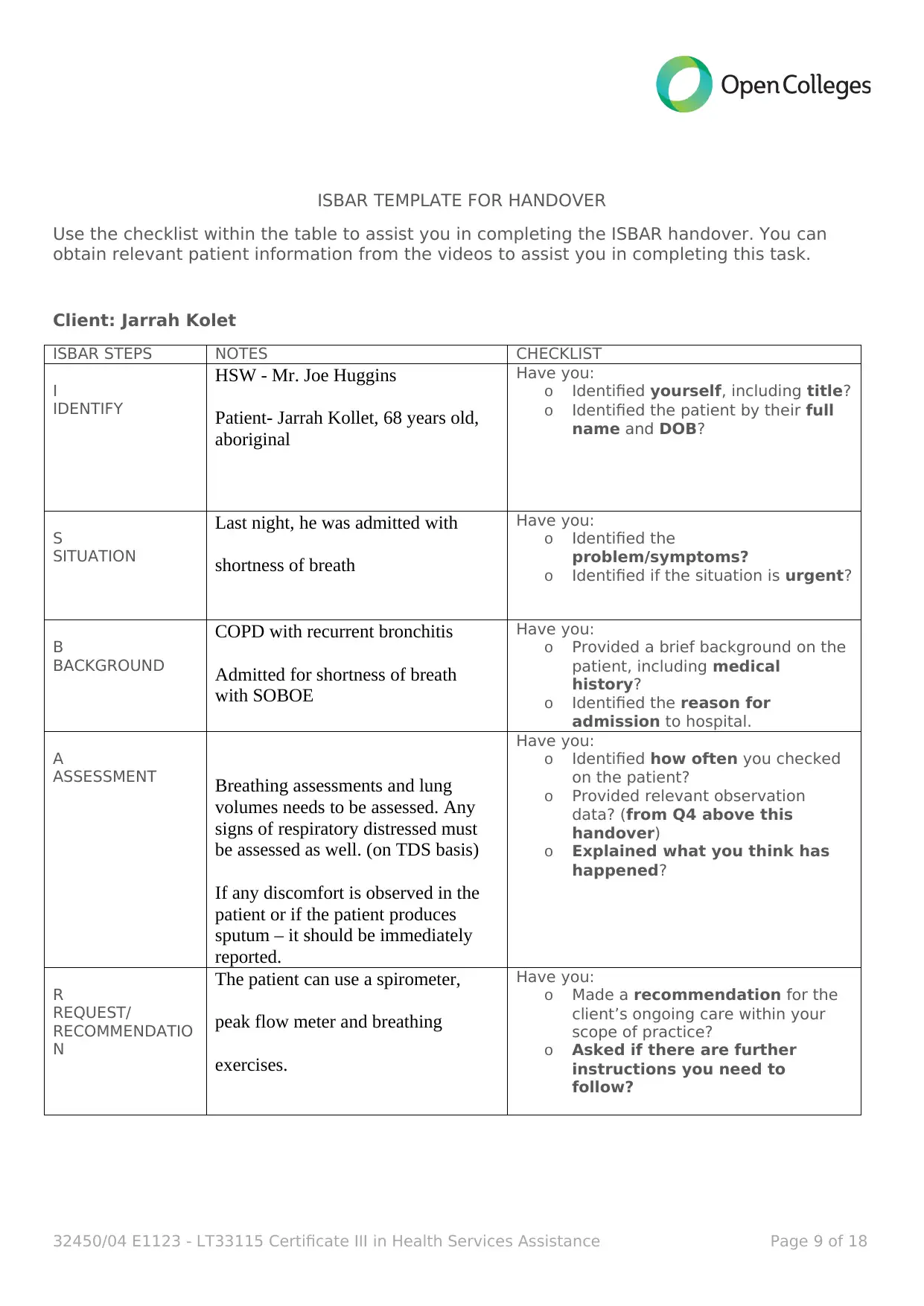
ISBAR TEMPLATE FOR HANDOVER
Use the checklist within the table to assist you in completing the ISBAR handover. You can
obtain relevant patient information from the videos to assist you in completing this task.
Client: Jarrah Kolet
ISBAR STEPS NOTES CHECKLIST
I
IDENTIFY
HSW - Mr. Joe Huggins
Patient- Jarrah Kollet, 68 years old,
aboriginal
Have you:
o Identified yourself, including title?
o Identified the patient by their full
name and DOB?
S
SITUATION
Last night, he was admitted with
shortness of breath
Have you:
o Identified the
problem/symptoms?
o Identified if the situation is urgent?
B
BACKGROUND
COPD with recurrent bronchitis
Admitted for shortness of breath
with SOBOE
Have you:
o Provided a brief background on the
patient, including medical
history?
o Identified the reason for
admission to hospital.
A
ASSESSMENT Breathing assessments and lung
volumes needs to be assessed. Any
signs of respiratory distressed must
be assessed as well. (on TDS basis)
If any discomfort is observed in the
patient or if the patient produces
sputum – it should be immediately
reported.
Have you:
o Identified how often you checked
on the patient?
o Provided relevant observation
data? (from Q4 above this
handover)
o Explained what you think has
happened?
R
REQUEST/
RECOMMENDATIO
N
The patient can use a spirometer,
peak flow meter and breathing
exercises.
Have you:
o Made a recommendation for the
client’s ongoing care within your
scope of practice?
o Asked if there are further
instructions you need to
follow?
32450/04 E1123 - LT33115 Certificate III in Health Services Assistance Page 9 of 18
Use the checklist within the table to assist you in completing the ISBAR handover. You can
obtain relevant patient information from the videos to assist you in completing this task.
Client: Jarrah Kolet
ISBAR STEPS NOTES CHECKLIST
I
IDENTIFY
HSW - Mr. Joe Huggins
Patient- Jarrah Kollet, 68 years old,
aboriginal
Have you:
o Identified yourself, including title?
o Identified the patient by their full
name and DOB?
S
SITUATION
Last night, he was admitted with
shortness of breath
Have you:
o Identified the
problem/symptoms?
o Identified if the situation is urgent?
B
BACKGROUND
COPD with recurrent bronchitis
Admitted for shortness of breath
with SOBOE
Have you:
o Provided a brief background on the
patient, including medical
history?
o Identified the reason for
admission to hospital.
A
ASSESSMENT Breathing assessments and lung
volumes needs to be assessed. Any
signs of respiratory distressed must
be assessed as well. (on TDS basis)
If any discomfort is observed in the
patient or if the patient produces
sputum – it should be immediately
reported.
Have you:
o Identified how often you checked
on the patient?
o Provided relevant observation
data? (from Q4 above this
handover)
o Explained what you think has
happened?
R
REQUEST/
RECOMMENDATIO
N
The patient can use a spirometer,
peak flow meter and breathing
exercises.
Have you:
o Made a recommendation for the
client’s ongoing care within your
scope of practice?
o Asked if there are further
instructions you need to
follow?
32450/04 E1123 - LT33115 Certificate III in Health Services Assistance Page 9 of 18
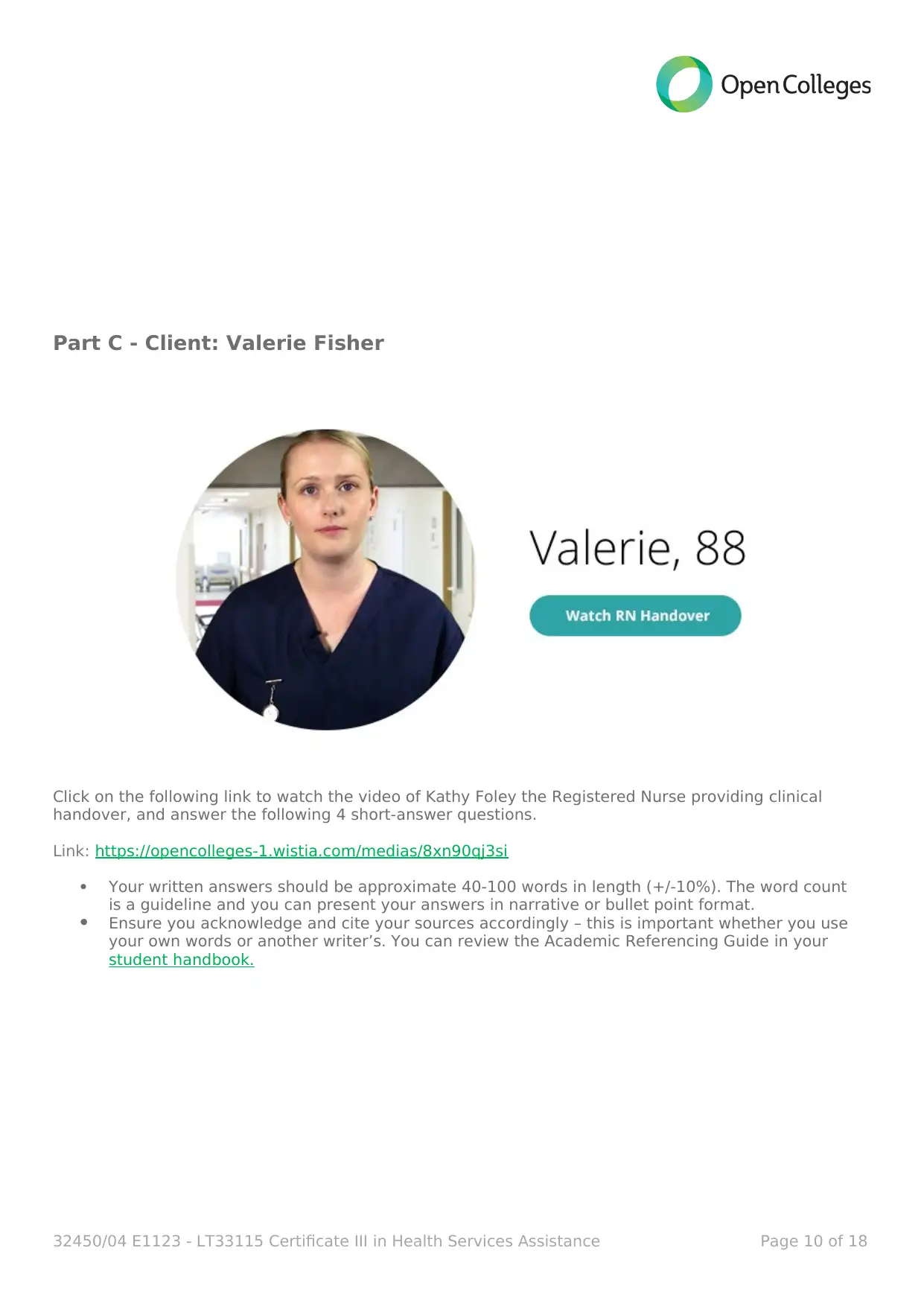
Part C - Client: Valerie Fisher
Click on the following link to watch the video of Kathy Foley the Registered Nurse providing clinical
handover, and answer the following 4 short-answer questions.
Link: https://opencolleges-1.wistia.com/medias/8xn90qj3si
Your written answers should be approximate 40-100 words in length (+/-10%). The word count
is a guideline and you can present your answers in narrative or bullet point format.
Ensure you acknowledge and cite your sources accordingly – this is important whether you use
your own words or another writer’s. You can review the Academic Referencing Guide in your
student handbook.
32450/04 E1123 - LT33115 Certificate III in Health Services Assistance Page 10 of 18
Click on the following link to watch the video of Kathy Foley the Registered Nurse providing clinical
handover, and answer the following 4 short-answer questions.
Link: https://opencolleges-1.wistia.com/medias/8xn90qj3si
Your written answers should be approximate 40-100 words in length (+/-10%). The word count
is a guideline and you can present your answers in narrative or bullet point format.
Ensure you acknowledge and cite your sources accordingly – this is important whether you use
your own words or another writer’s. You can review the Academic Referencing Guide in your
student handbook.
32450/04 E1123 - LT33115 Certificate III in Health Services Assistance Page 10 of 18
Secure Best Marks with AI Grader
Need help grading? Try our AI Grader for instant feedback on your assignments.
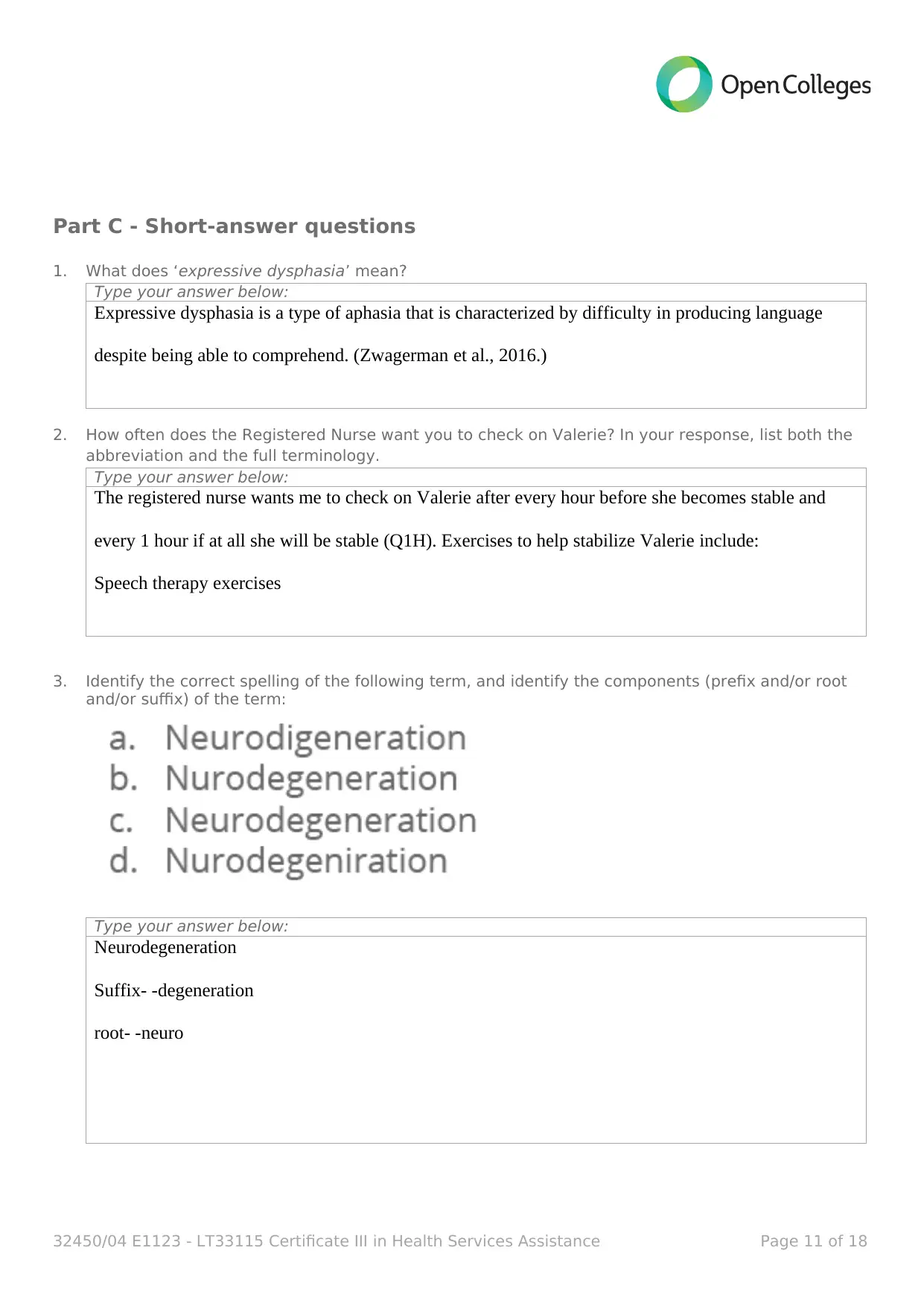
Part C - Short-answer questions
1. What does ‘expressive dysphasia’ mean?
Type your answer below:
Expressive dysphasia is a type of aphasia that is characterized by difficulty in producing language
despite being able to comprehend. (Zwagerman et al., 2016.)
2. How often does the Registered Nurse want you to check on Valerie? In your response, list both the
abbreviation and the full terminology.
Type your answer below:
The registered nurse wants me to check on Valerie after every hour before she becomes stable and
every 1 hour if at all she will be stable (Q1H). Exercises to help stabilize Valerie include:
Speech therapy exercises
3. Identify the correct spelling of the following term, and identify the components (prefix and/or root
and/or suffix) of the term:
Type your answer below:
Neurodegeneration
Suffix- -degeneration
root- -neuro
32450/04 E1123 - LT33115 Certificate III in Health Services Assistance Page 11 of 18
1. What does ‘expressive dysphasia’ mean?
Type your answer below:
Expressive dysphasia is a type of aphasia that is characterized by difficulty in producing language
despite being able to comprehend. (Zwagerman et al., 2016.)
2. How often does the Registered Nurse want you to check on Valerie? In your response, list both the
abbreviation and the full terminology.
Type your answer below:
The registered nurse wants me to check on Valerie after every hour before she becomes stable and
every 1 hour if at all she will be stable (Q1H). Exercises to help stabilize Valerie include:
Speech therapy exercises
3. Identify the correct spelling of the following term, and identify the components (prefix and/or root
and/or suffix) of the term:
Type your answer below:
Neurodegeneration
Suffix- -degeneration
root- -neuro
32450/04 E1123 - LT33115 Certificate III in Health Services Assistance Page 11 of 18
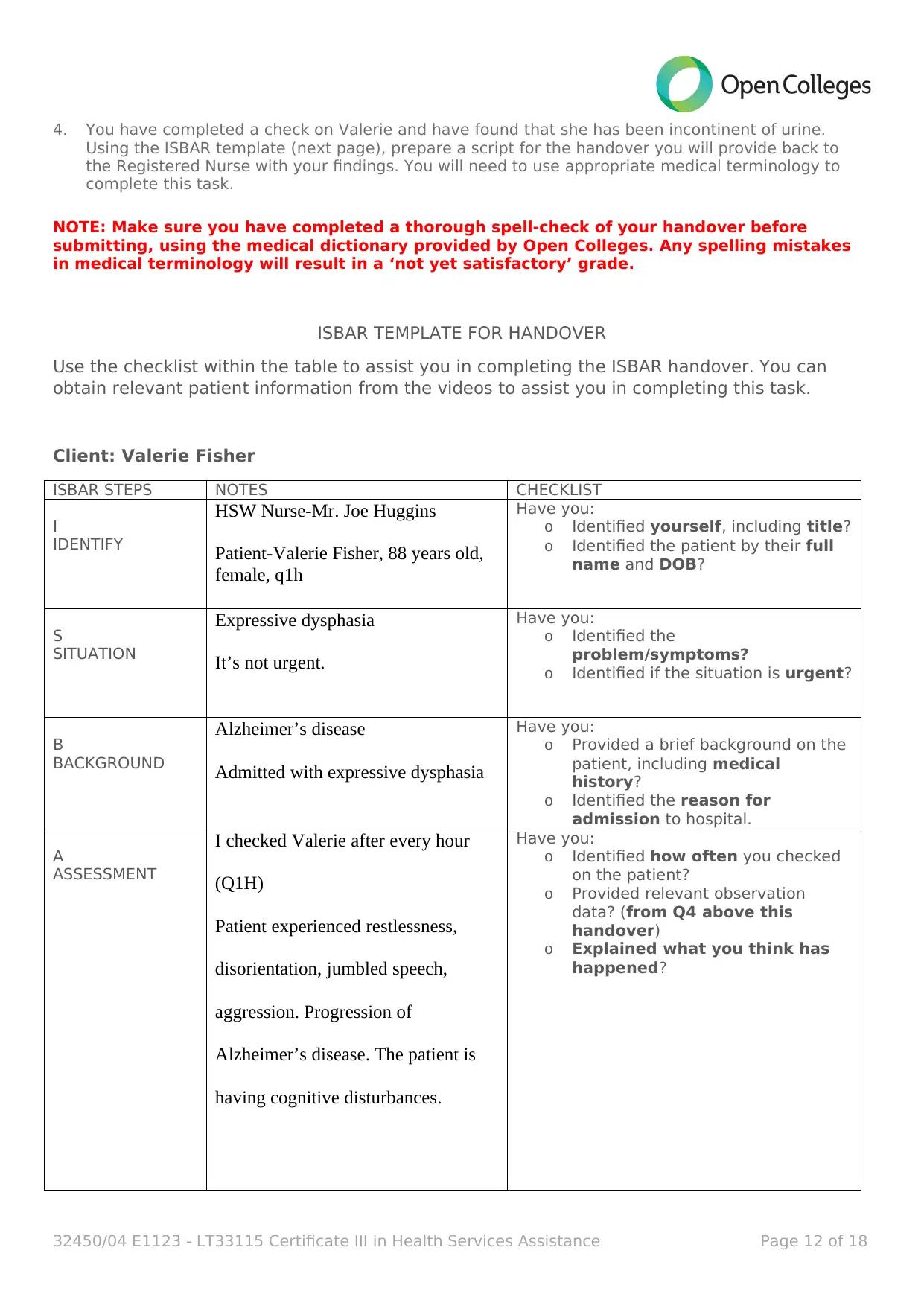
4. You have completed a check on Valerie and have found that she has been incontinent of urine.
Using the ISBAR template (next page), prepare a script for the handover you will provide back to
the Registered Nurse with your findings. You will need to use appropriate medical terminology to
complete this task.
NOTE: Make sure you have completed a thorough spell-check of your handover before
submitting, using the medical dictionary provided by Open Colleges. Any spelling mistakes
in medical terminology will result in a ‘not yet satisfactory’ grade.
ISBAR TEMPLATE FOR HANDOVER
Use the checklist within the table to assist you in completing the ISBAR handover. You can
obtain relevant patient information from the videos to assist you in completing this task.
Client: Valerie Fisher
ISBAR STEPS NOTES CHECKLIST
I
IDENTIFY
HSW Nurse-Mr. Joe Huggins
Patient-Valerie Fisher, 88 years old,
female, q1h
Have you:
o Identified yourself, including title?
o Identified the patient by their full
name and DOB?
S
SITUATION
Expressive dysphasia
It’s not urgent.
Have you:
o Identified the
problem/symptoms?
o Identified if the situation is urgent?
B
BACKGROUND
Alzheimer’s disease
Admitted with expressive dysphasia
Have you:
o Provided a brief background on the
patient, including medical
history?
o Identified the reason for
admission to hospital.
A
ASSESSMENT
I checked Valerie after every hour
(Q1H)
Patient experienced restlessness,
disorientation, jumbled speech,
aggression. Progression of
Alzheimer’s disease. The patient is
having cognitive disturbances.
Have you:
o Identified how often you checked
on the patient?
o Provided relevant observation
data? (from Q4 above this
handover)
o Explained what you think has
happened?
32450/04 E1123 - LT33115 Certificate III in Health Services Assistance Page 12 of 18
Using the ISBAR template (next page), prepare a script for the handover you will provide back to
the Registered Nurse with your findings. You will need to use appropriate medical terminology to
complete this task.
NOTE: Make sure you have completed a thorough spell-check of your handover before
submitting, using the medical dictionary provided by Open Colleges. Any spelling mistakes
in medical terminology will result in a ‘not yet satisfactory’ grade.
ISBAR TEMPLATE FOR HANDOVER
Use the checklist within the table to assist you in completing the ISBAR handover. You can
obtain relevant patient information from the videos to assist you in completing this task.
Client: Valerie Fisher
ISBAR STEPS NOTES CHECKLIST
I
IDENTIFY
HSW Nurse-Mr. Joe Huggins
Patient-Valerie Fisher, 88 years old,
female, q1h
Have you:
o Identified yourself, including title?
o Identified the patient by their full
name and DOB?
S
SITUATION
Expressive dysphasia
It’s not urgent.
Have you:
o Identified the
problem/symptoms?
o Identified if the situation is urgent?
B
BACKGROUND
Alzheimer’s disease
Admitted with expressive dysphasia
Have you:
o Provided a brief background on the
patient, including medical
history?
o Identified the reason for
admission to hospital.
A
ASSESSMENT
I checked Valerie after every hour
(Q1H)
Patient experienced restlessness,
disorientation, jumbled speech,
aggression. Progression of
Alzheimer’s disease. The patient is
having cognitive disturbances.
Have you:
o Identified how often you checked
on the patient?
o Provided relevant observation
data? (from Q4 above this
handover)
o Explained what you think has
happened?
32450/04 E1123 - LT33115 Certificate III in Health Services Assistance Page 12 of 18
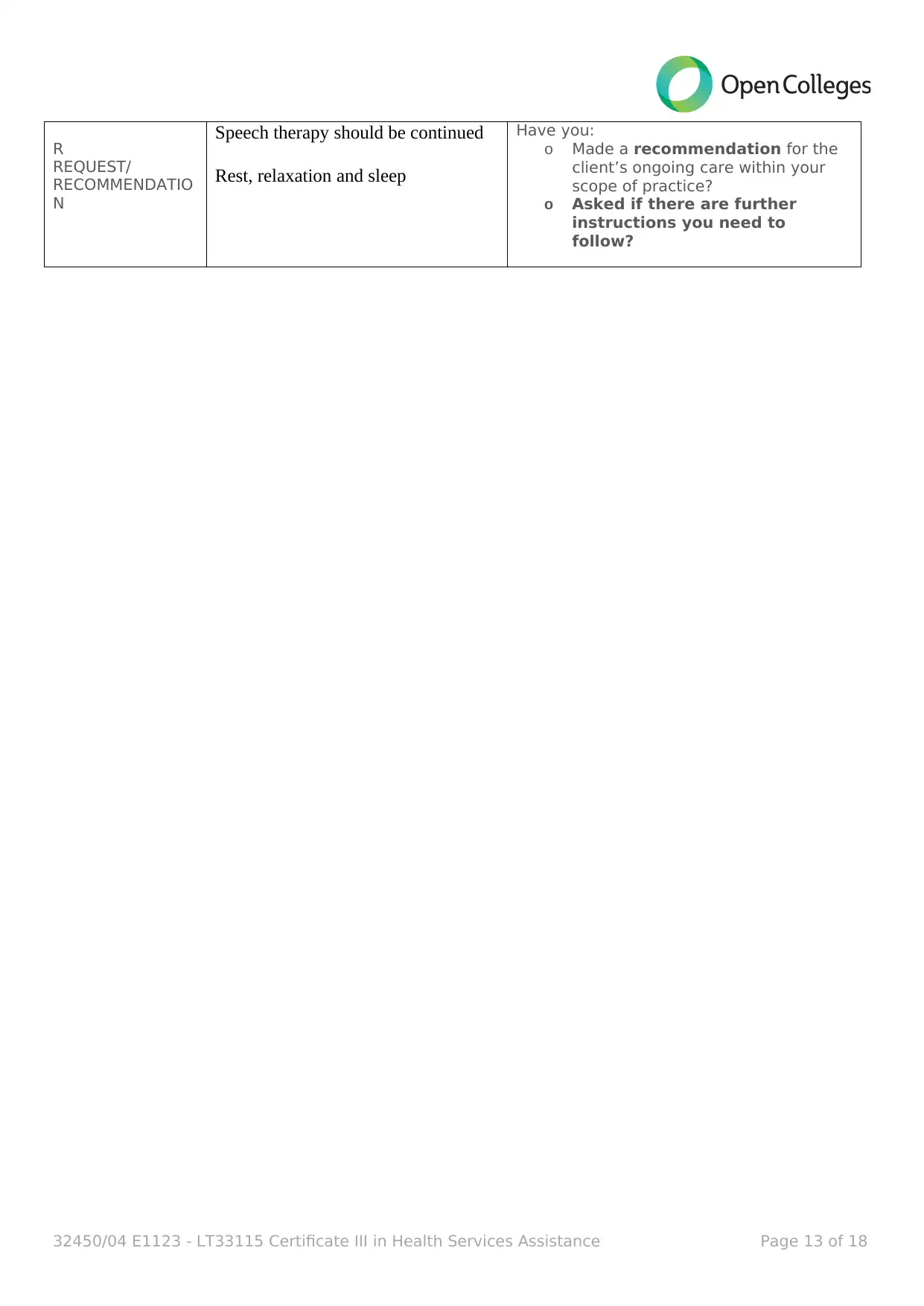
R
REQUEST/
RECOMMENDATIO
N
Speech therapy should be continued
Rest, relaxation and sleep
Have you:
o Made a recommendation for the
client’s ongoing care within your
scope of practice?
o Asked if there are further
instructions you need to
follow?
32450/04 E1123 - LT33115 Certificate III in Health Services Assistance Page 13 of 18
REQUEST/
RECOMMENDATIO
N
Speech therapy should be continued
Rest, relaxation and sleep
Have you:
o Made a recommendation for the
client’s ongoing care within your
scope of practice?
o Asked if there are further
instructions you need to
follow?
32450/04 E1123 - LT33115 Certificate III in Health Services Assistance Page 13 of 18
Paraphrase This Document
Need a fresh take? Get an instant paraphrase of this document with our AI Paraphraser
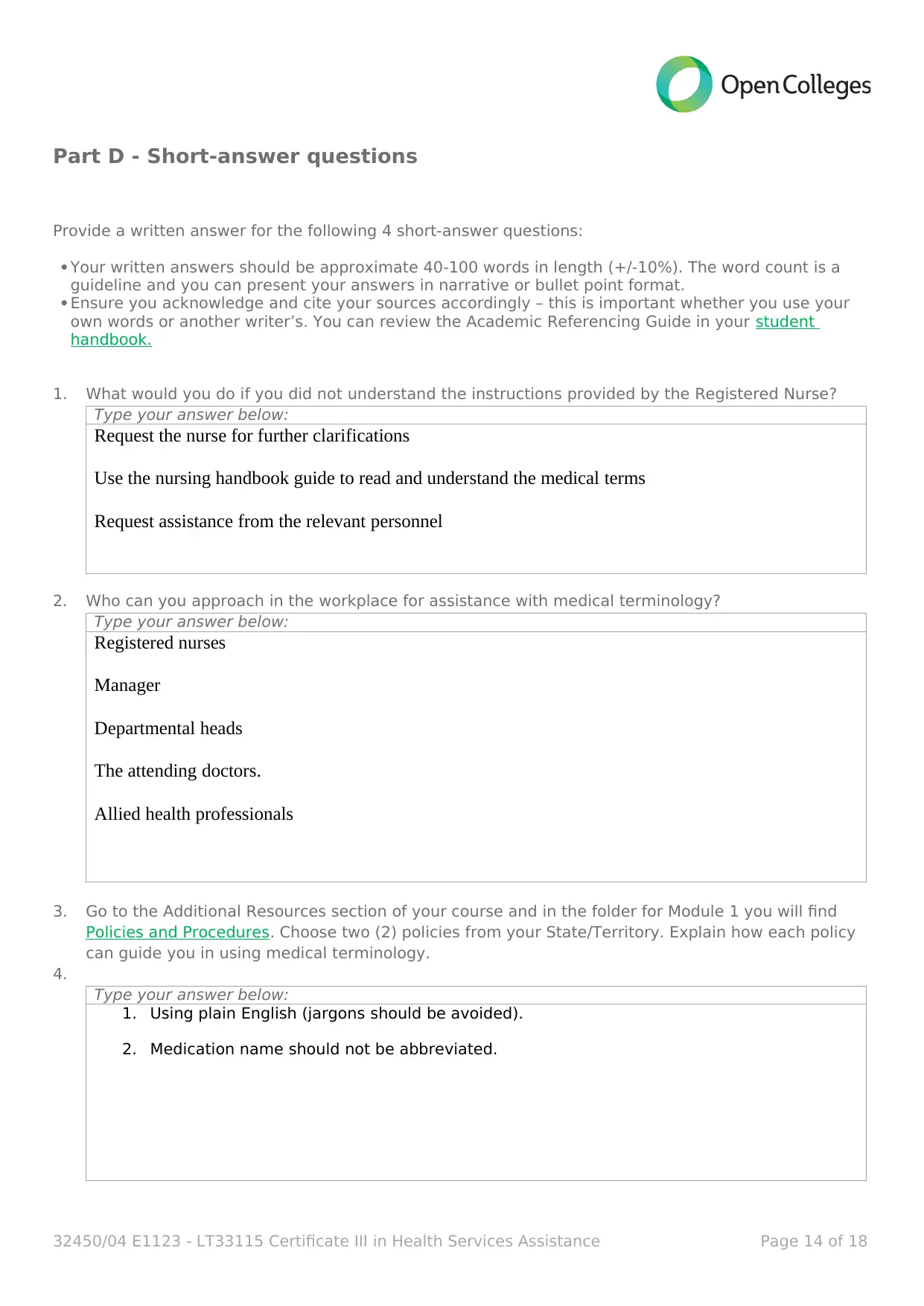
Part D - Short-answer questions
Provide a written answer for the following 4 short-answer questions:
Your written answers should be approximate 40-100 words in length (+/-10%). The word count is a
guideline and you can present your answers in narrative or bullet point format.
Ensure you acknowledge and cite your sources accordingly – this is important whether you use your
own words or another writer’s. You can review the Academic Referencing Guide in your student
handbook.
1. What would you do if you did not understand the instructions provided by the Registered Nurse?
Type your answer below:
Request the nurse for further clarifications
Use the nursing handbook guide to read and understand the medical terms
Request assistance from the relevant personnel
2. Who can you approach in the workplace for assistance with medical terminology?
Type your answer below:
Registered nurses
Manager
Departmental heads
The attending doctors.
Allied health professionals
3. Go to the Additional Resources section of your course and in the folder for Module 1 you will find
Policies and Procedures. Choose two (2) policies from your State/Territory. Explain how each policy
can guide you in using medical terminology.
4.
Type your answer below:
1. Using plain English (jargons should be avoided).
2. Medication name should not be abbreviated.
32450/04 E1123 - LT33115 Certificate III in Health Services Assistance Page 14 of 18
Provide a written answer for the following 4 short-answer questions:
Your written answers should be approximate 40-100 words in length (+/-10%). The word count is a
guideline and you can present your answers in narrative or bullet point format.
Ensure you acknowledge and cite your sources accordingly – this is important whether you use your
own words or another writer’s. You can review the Academic Referencing Guide in your student
handbook.
1. What would you do if you did not understand the instructions provided by the Registered Nurse?
Type your answer below:
Request the nurse for further clarifications
Use the nursing handbook guide to read and understand the medical terms
Request assistance from the relevant personnel
2. Who can you approach in the workplace for assistance with medical terminology?
Type your answer below:
Registered nurses
Manager
Departmental heads
The attending doctors.
Allied health professionals
3. Go to the Additional Resources section of your course and in the folder for Module 1 you will find
Policies and Procedures. Choose two (2) policies from your State/Territory. Explain how each policy
can guide you in using medical terminology.
4.
Type your answer below:
1. Using plain English (jargons should be avoided).
2. Medication name should not be abbreviated.
32450/04 E1123 - LT33115 Certificate III in Health Services Assistance Page 14 of 18
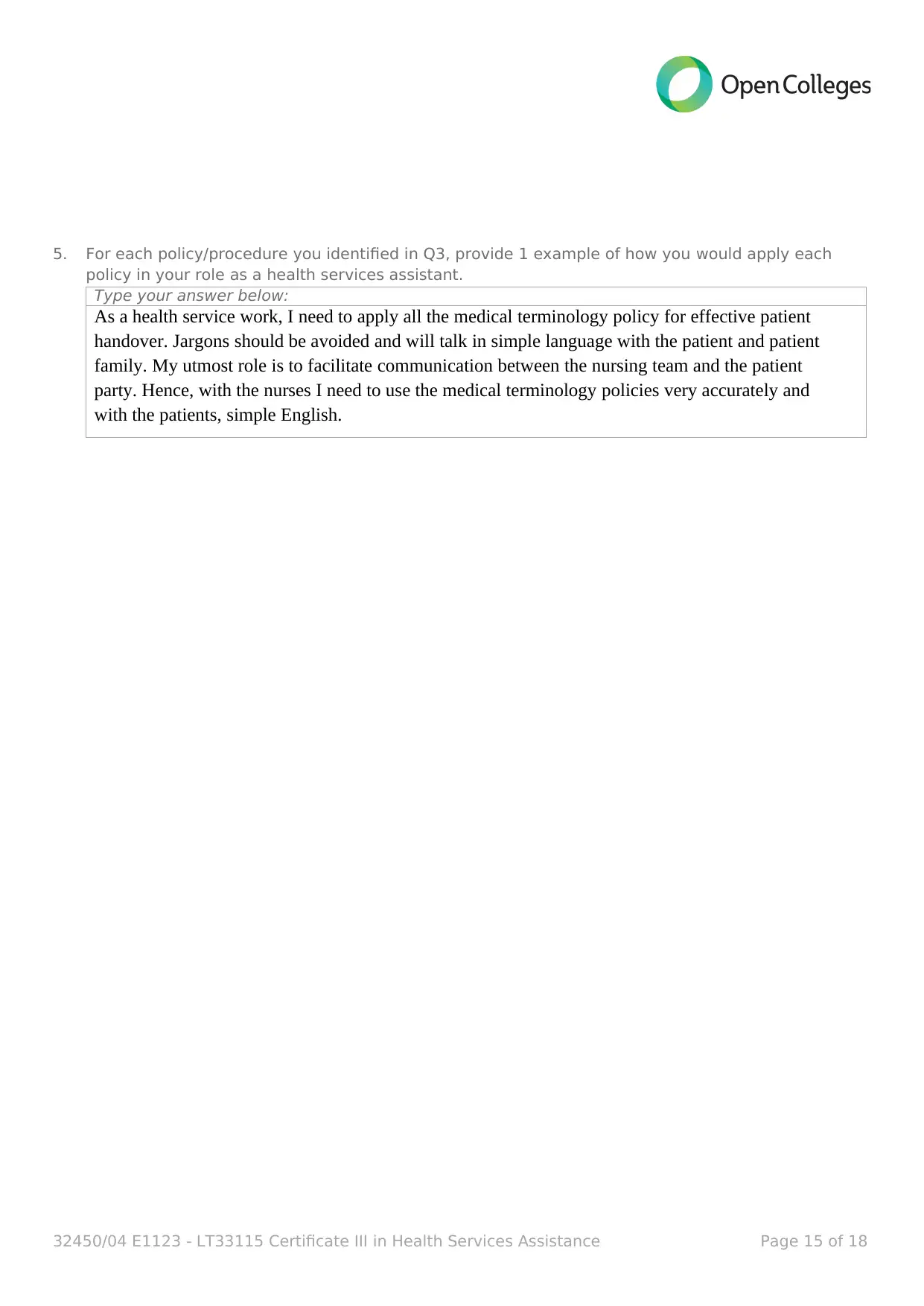
5. For each policy/procedure you identified in Q3, provide 1 example of how you would apply each
policy in your role as a health services assistant.
Type your answer below:
As a health service work, I need to apply all the medical terminology policy for effective patient
handover. Jargons should be avoided and will talk in simple language with the patient and patient
family. My utmost role is to facilitate communication between the nursing team and the patient
party. Hence, with the nurses I need to use the medical terminology policies very accurately and
with the patients, simple English.
32450/04 E1123 - LT33115 Certificate III in Health Services Assistance Page 15 of 18
policy in your role as a health services assistant.
Type your answer below:
As a health service work, I need to apply all the medical terminology policy for effective patient
handover. Jargons should be avoided and will talk in simple language with the patient and patient
family. My utmost role is to facilitate communication between the nursing team and the patient
party. Hence, with the nurses I need to use the medical terminology policies very accurately and
with the patients, simple English.
32450/04 E1123 - LT33115 Certificate III in Health Services Assistance Page 15 of 18
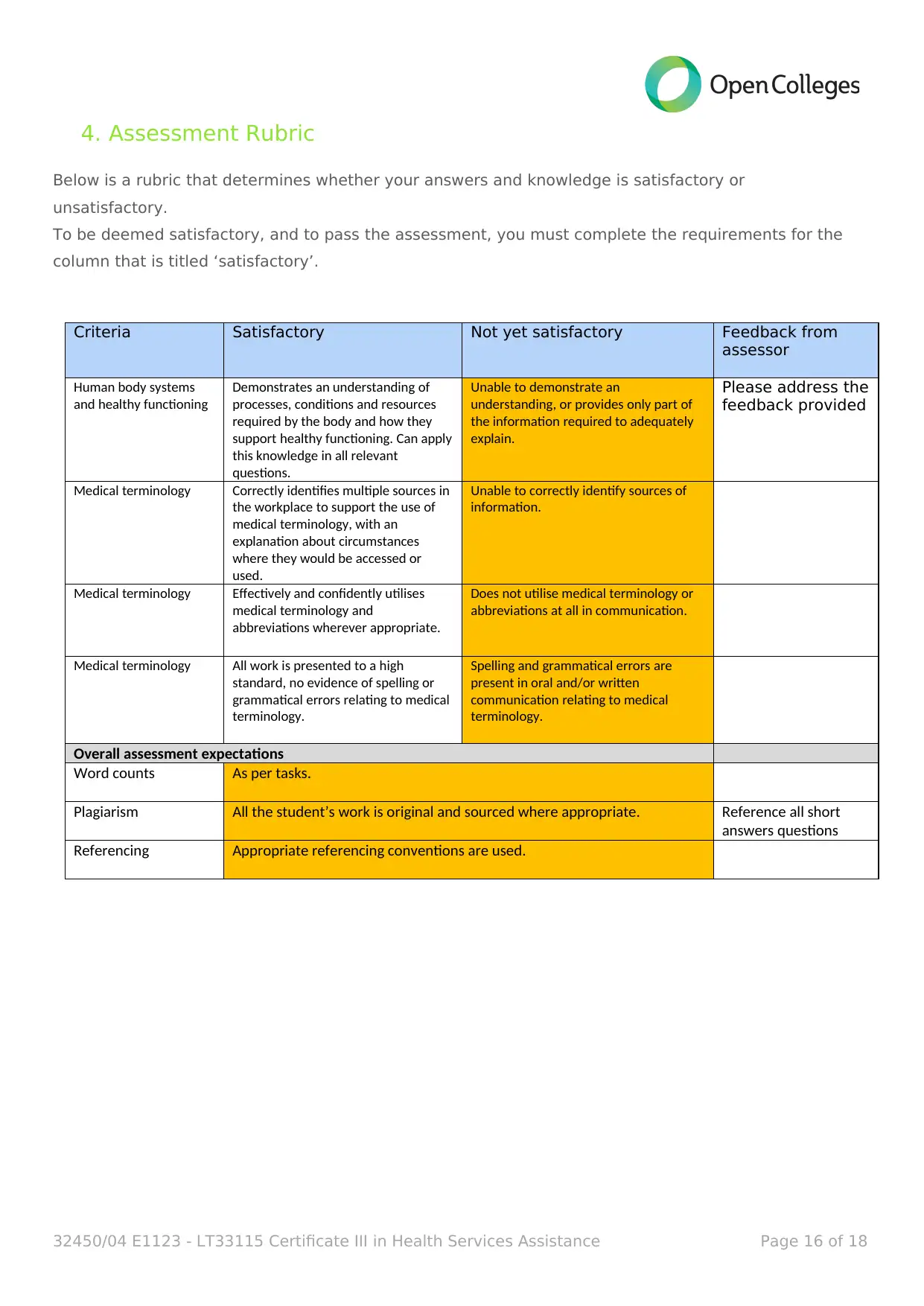
4. Assessment Rubric
Below is a rubric that determines whether your answers and knowledge is satisfactory or
unsatisfactory.
To be deemed satisfactory, and to pass the assessment, you must complete the requirements for the
column that is titled ‘satisfactory’.
32450/04 E1123 - LT33115 Certificate III in Health Services Assistance Page 16 of 18
Criteria Satisfactory Not yet satisfactory Feedback from
assessor
Human body systems
and healthy functioning
Demonstrates an understanding of
processes, conditions and resources
required by the body and how they
support healthy functioning. Can apply
this knowledge in all relevant
questions.
Unable to demonstrate an
understanding, or provides only part of
the information required to adequately
explain.
Please address the
feedback provided
Medical terminology Correctly identifies multiple sources in
the workplace to support the use of
medical terminology, with an
explanation about circumstances
where they would be accessed or
used.
Unable to correctly identify sources of
information.
Medical terminology Effectively and confidently utilises
medical terminology and
abbreviations wherever appropriate.
Does not utilise medical terminology or
abbreviations at all in communication.
Medical terminology All work is presented to a high
standard, no evidence of spelling or
grammatical errors relating to medical
terminology.
Spelling and grammatical errors are
present in oral and/or written
communication relating to medical
terminology.
Overall assessment expectations
Word counts As per tasks.
Plagiarism All the student’s work is original and sourced where appropriate. Reference all short
answers questions
Referencing Appropriate referencing conventions are used.
Below is a rubric that determines whether your answers and knowledge is satisfactory or
unsatisfactory.
To be deemed satisfactory, and to pass the assessment, you must complete the requirements for the
column that is titled ‘satisfactory’.
32450/04 E1123 - LT33115 Certificate III in Health Services Assistance Page 16 of 18
Criteria Satisfactory Not yet satisfactory Feedback from
assessor
Human body systems
and healthy functioning
Demonstrates an understanding of
processes, conditions and resources
required by the body and how they
support healthy functioning. Can apply
this knowledge in all relevant
questions.
Unable to demonstrate an
understanding, or provides only part of
the information required to adequately
explain.
Please address the
feedback provided
Medical terminology Correctly identifies multiple sources in
the workplace to support the use of
medical terminology, with an
explanation about circumstances
where they would be accessed or
used.
Unable to correctly identify sources of
information.
Medical terminology Effectively and confidently utilises
medical terminology and
abbreviations wherever appropriate.
Does not utilise medical terminology or
abbreviations at all in communication.
Medical terminology All work is presented to a high
standard, no evidence of spelling or
grammatical errors relating to medical
terminology.
Spelling and grammatical errors are
present in oral and/or written
communication relating to medical
terminology.
Overall assessment expectations
Word counts As per tasks.
Plagiarism All the student’s work is original and sourced where appropriate. Reference all short
answers questions
Referencing Appropriate referencing conventions are used.
Secure Best Marks with AI Grader
Need help grading? Try our AI Grader for instant feedback on your assignments.
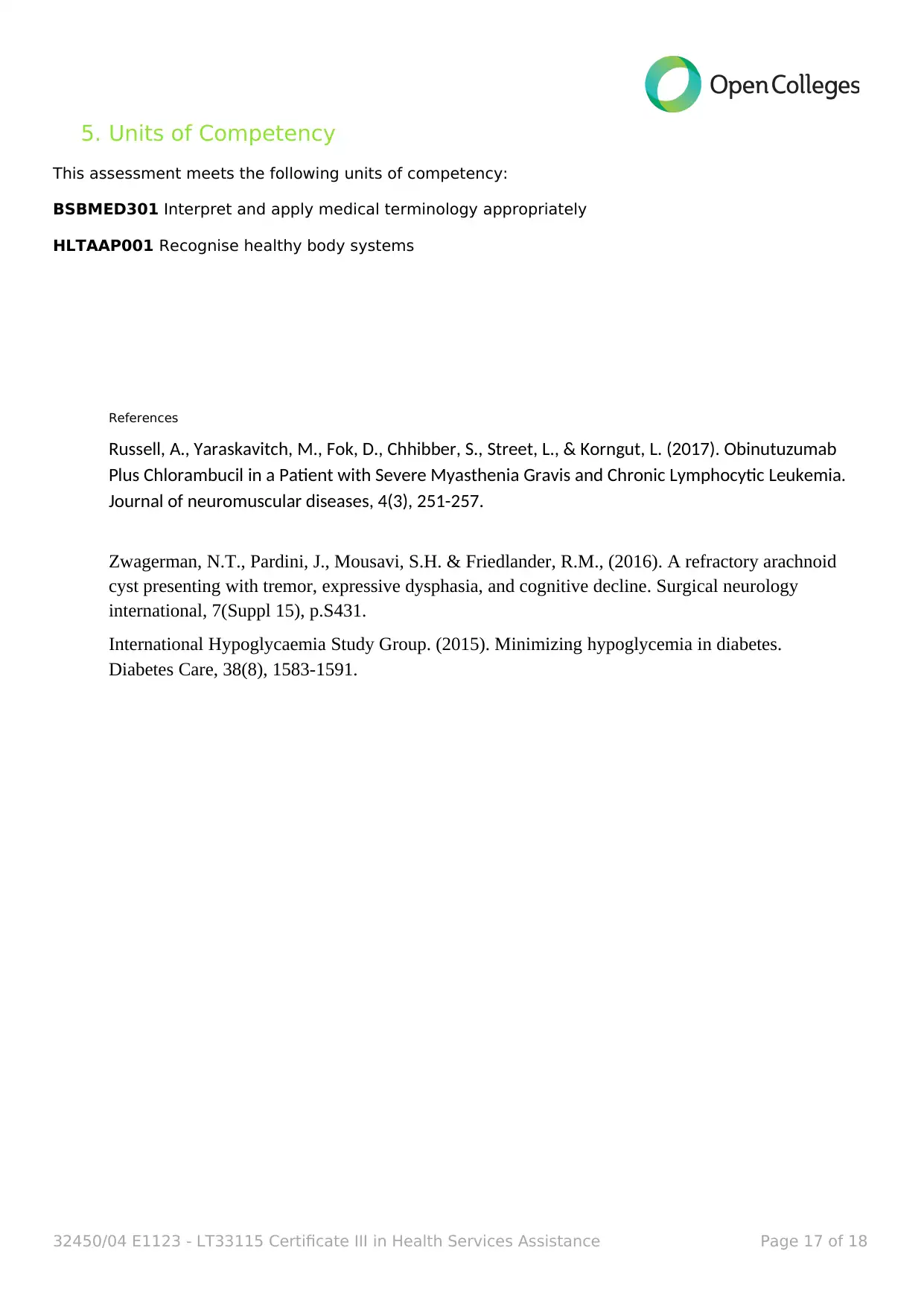
5. Units of Competency
This assessment meets the following units of competency:
BSBMED301 Interpret and apply medical terminology appropriately
HLTAAP001 Recognise healthy body systems
References
Russell, A., Yaraskavitch, M., Fok, D., Chhibber, S., Street, L., & Korngut, L. (2017). Obinutuzumab
Plus Chlorambucil in a Patient with Severe Myasthenia Gravis and Chronic Lymphocytic Leukemia.
Journal of neuromuscular diseases, 4(3), 251-257.
Zwagerman, N.T., Pardini, J., Mousavi, S.H. & Friedlander, R.M., (2016). A refractory arachnoid
cyst presenting with tremor, expressive dysphasia, and cognitive decline. Surgical neurology
international, 7(Suppl 15), p.S431.
International Hypoglycaemia Study Group. (2015). Minimizing hypoglycemia in diabetes.
Diabetes Care, 38(8), 1583-1591.
32450/04 E1123 - LT33115 Certificate III in Health Services Assistance Page 17 of 18
This assessment meets the following units of competency:
BSBMED301 Interpret and apply medical terminology appropriately
HLTAAP001 Recognise healthy body systems
References
Russell, A., Yaraskavitch, M., Fok, D., Chhibber, S., Street, L., & Korngut, L. (2017). Obinutuzumab
Plus Chlorambucil in a Patient with Severe Myasthenia Gravis and Chronic Lymphocytic Leukemia.
Journal of neuromuscular diseases, 4(3), 251-257.
Zwagerman, N.T., Pardini, J., Mousavi, S.H. & Friedlander, R.M., (2016). A refractory arachnoid
cyst presenting with tremor, expressive dysphasia, and cognitive decline. Surgical neurology
international, 7(Suppl 15), p.S431.
International Hypoglycaemia Study Group. (2015). Minimizing hypoglycemia in diabetes.
Diabetes Care, 38(8), 1583-1591.
32450/04 E1123 - LT33115 Certificate III in Health Services Assistance Page 17 of 18
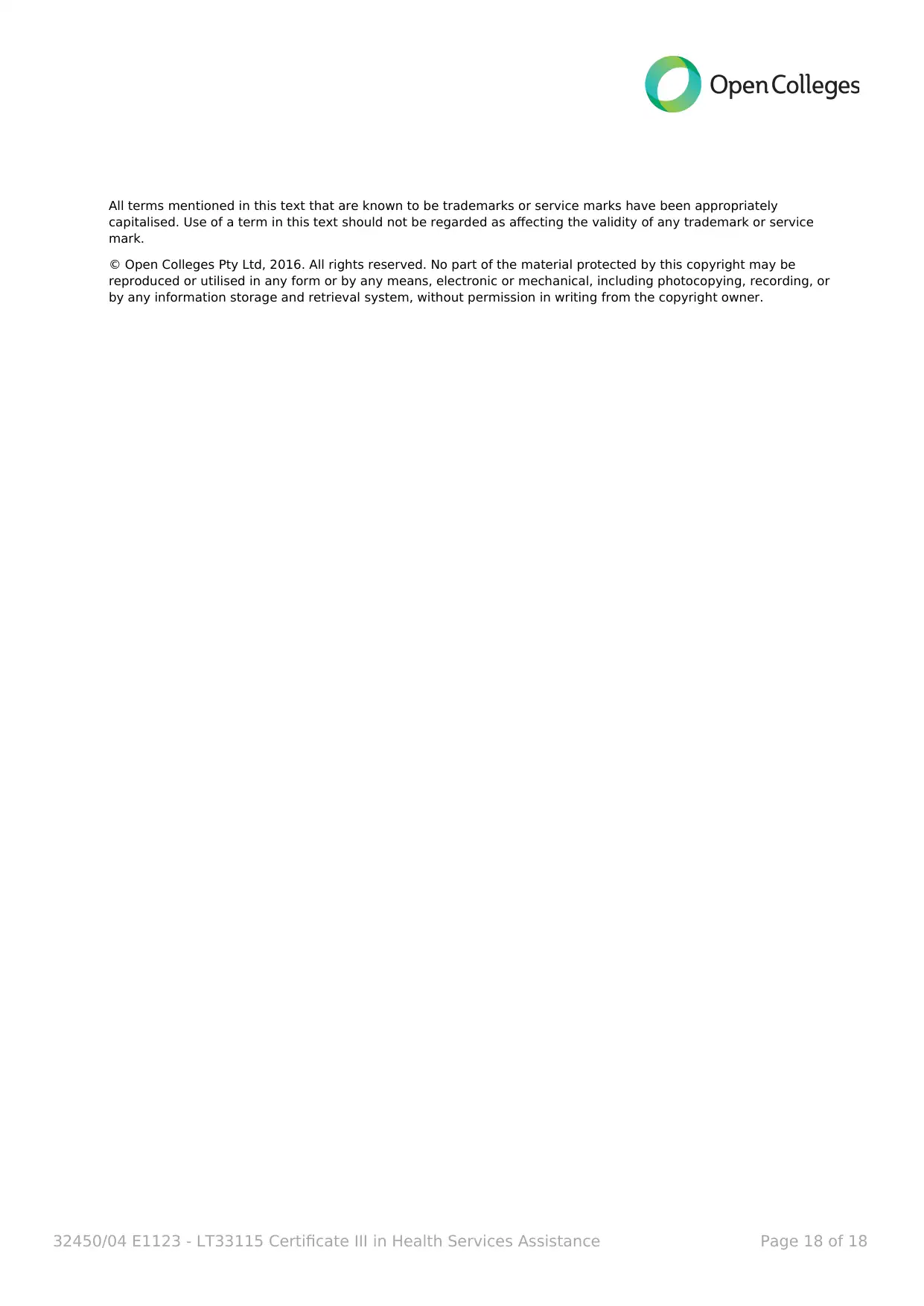
All terms mentioned in this text that are known to be trademarks or service marks have been appropriately
capitalised. Use of a term in this text should not be regarded as affecting the validity of any trademark or service
mark.
© Open Colleges Pty Ltd, 2016. All rights reserved. No part of the material protected by this copyright may be
reproduced or utilised in any form or by any means, electronic or mechanical, including photocopying, recording, or
by any information storage and retrieval system, without permission in writing from the copyright owner.
32450/04 E1123 - LT33115 Certificate III in Health Services Assistance Page 18 of 18
capitalised. Use of a term in this text should not be regarded as affecting the validity of any trademark or service
mark.
© Open Colleges Pty Ltd, 2016. All rights reserved. No part of the material protected by this copyright may be
reproduced or utilised in any form or by any means, electronic or mechanical, including photocopying, recording, or
by any information storage and retrieval system, without permission in writing from the copyright owner.
32450/04 E1123 - LT33115 Certificate III in Health Services Assistance Page 18 of 18
1 out of 18
Your All-in-One AI-Powered Toolkit for Academic Success.
+13062052269
info@desklib.com
Available 24*7 on WhatsApp / Email
![[object Object]](/_next/static/media/star-bottom.7253800d.svg)
Unlock your academic potential
© 2024 | Zucol Services PVT LTD | All rights reserved.




